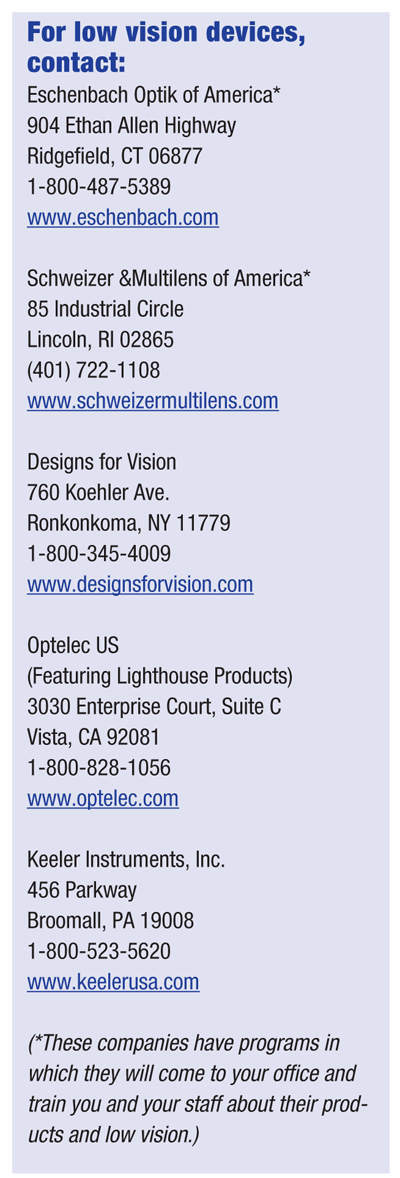
Consider this scenario: An elderly female patient who has age-related macular degeneration (AMD) struggles to read her mail. Her store-bought magnifying glass is no longer strong enough, so she now looks to you for help. Based on her eye exam, you offer her a portable magnifier in 3.5x power, a 3x LED-lit round handheld magnifier and a 3.5x rectangular illuminated lamp. She tries viewing some catalogs and the newspaper with the handheld magnifier, and shes sold. Much to her delight, you learn at her follow-up, she is able to read her mail again.
Success stories such as this are one reason to consider incorporating low vision rehab into your primary-care optometry practice. Here are a few more:
The first wave of the 78 million baby boomers, including President Bush, turned 60 this year, signaling a population shift toward a more mature patient base than ever before.1
In the United States alone, 1.75 million people ages 40 and older have AMD. By 2020, an estimated 2.95 million Americans will have AMDan increase of 50%. Worldwide, AMD will affect 45 million adults past age 75, rendering them legally blind and unable to perform everyday tasks, such as reading, writing and watching television, without some assistive device.2
Some 20.9% of people past age 60 have diabetes and are at risk for vision loss from diabetic retinopathy. Another 2 million people are visually impaired from glaucoma, and 4 million have corneal opacities.3 These people will need some form of vision assistance to function and perform everyday tasks.
 Getting Started
Getting Started
The most important referral source for a low vision practice is a retinal specialist. I worked with two retinal specialists for 16 years who referred many patients to me. I also benefited from their referral sources, namely the doctors who sent patients to them. Any time they referred a patient to me, I sent a report to the retinal specialist and copies to the original optometrist or ophthalmologist and the patients general practitioner. Other local practitioners became familiar with me and the low vision services I offered.
When I moved into my new practice, I sent a letter to all the eye- and health-care practitioners in the area detailing my low vision services. Then, I visited different doctors in my area each week for the first year. This way, they could put a face to my name.
Also, I offer to give presentations for groups who may be interested, such as senior citizens groups and the Lions and Rotary clubs. This educates them about low vision services and brings in new patientsslowly, but surely.
In
Keep in mind that your current patients most likely have aging relatives or friends with age-related eye diseases and subsequent vision loss, and may be looking (in all the wrong places, perhaps) for someone to help them. If you choose to offer low vision services in your practiceeven at the simplest levelyou may attain a lifetime patient, and he or she may refer additional patients.
Make sure to have a write-up in your practices newsletter and/or the Web site about your low vision services. One survey showed that 47% of patients with low vision were told that nothing could be done for them, and only 30% of all patients with low vision learned from their eye care professional about low vision services.4 So, make sure to let your patientsand potential patientsknow what you can do for them.
 The Right Equipment
The Right Equipment
Your exam lane will serve you just as well for a low vision examination as for a general optometric examination. But, for a low vision refraction, you will find that a trial frame and loose lenses suit you best.
Other equipment you will need:5
A low vision chart to determine the patients acuity. There are several to choose from. I use the SOSH (Student Optometric Service to Humanity Project) low vision chart. Designs for Vision still makes the original Feinbloom low vision chart, while Eschenbach Optik offers the DVI-Chart for distance testing. Optelec
Distance charts are designed to be used at a starting distance of 20 feet, but you can move them to any distance at which the patient is able to see. Most often, these are used at a distance of 10 feet. Also, make sure that your chart is well-lit; I use a fluorescent light and shine it directly onto the chart.
Reading cards to assess a patients near acuity. A variety of cards are available. The near acuity card from Eschenbach Optik provides Snellen acuity, add powers needed to read newspaper print (1M), and letter size in M units and X magnification, which can be helpfulespecially for novices. The Lighthouse continuous text card for adults keeps patients interested as they read, and it gives both Snellen acuity and metric print size (i.e. 20/100 =2.0M).
An Amsler grid card to assess the integrity of the macula. Look for scotomas and distortion so that you can recommend where the patient can view eccentrically to avoid these areas while reading.
Lamps to perform a lighting assessment. I recommend two types of lighting: a high-intensity, double-reflector stand lamp (Grafco Model 1690) and a fluorescent floor model stand lamp (Verilux). The lighting assessment is simple to doand can be important for these patients.
Therapeutic Aids
Here are various low vision aids you might offer patients:
Glasses. These are the most frequently requested and prescribed optical device in low vision rehabilitation. Patients often prefer them because they are hands free and because they offer the largest field of view compared to other devices of the same magnification.6
Designs for patients with low vision include full-field glasses in a regular frame (single vision or multifocal) or half-eye frames, prism half-eyeglasses, aspheric microscopes and doublet systems. But, microscopes and doublet systems are more complicated and require more expertise and skill to prescribe.
 Patients who have conditions such as early-stage AMD generally require adds greater than +3.00D and sometimes as high as +7.00D or more. Educate patients to hold their reading material much closer. Many readily adjust to the change, since it offers them the ability to read.
Patients who have conditions such as early-stage AMD generally require adds greater than +3.00D and sometimes as high as +7.00D or more. Educate patients to hold their reading material much closer. Many readily adjust to the change, since it offers them the ability to read.
Another alternative: a reading only prescription, for which I recommend a half-eye frame. If the patient still has binocular vision, consider prescribing prism half-eye glasses. Optelec and COIL both offer these in +6/8 base in (BI), +8/10 BI, +10/12 BI, +12/14 BI, +14/16 BI.
Local labs will sometimes pre-make glasses by size and color to reduce delivery time. Also consider having the temples engraved with the patients name and phone number in case the glasses are lost or misplaced.
Magnifiers. Handheld magnifiers work best with short-term reading tasks, such as looking up a phone number or reading labels or price tags in a store. Explain to the patient that each magnifier has a specific focal length, so he or she must hold the magnifier at the proper length.
But, holding a handheld magnifier at a precise distance to read print can become tiresome, especially for older patients. For longer reading tasks, a stand illuminated magnifier works better; patients only need to slide it across the paper to read the print. The height of the stand determines its focal length, so it is not necessary to hold the magnifier up off the page. These are ideal for patients who have dexterity problems, arthritis or tremors. If your patients remain unconvinced, let them try a stand illuminated magnifier in your office.
Some manufacturers offer display units of their pocket, stand and handheld magnifiers, so you can let your patients know that you offer such devices. Also, make sure that your staff knows how to use at least the near acuity card to help patients become comfortable with them. (They should also remind patients that an evaluation is necessary to determine the appropriate device for them and that a prescription is necessary for any optical device.)
Electronic devices. Other devices for long-term reading and writing tasks include CCTV (closed-circuit TV), reading machines and pocket electronic magnifiers, such as the Amigo (Enhanced Vision). If you dont specialize in low vision, you probably wont have these in your office, so consider providing brochures and referring patients to the Association for the Blind for demonstrations. Also, company representatives often are willing to do in-home demonstrations of their products.
Lighting. To the visually-impaired patient, adequate lighting is as important as the appropriate magnifier. To reduce or eliminate glare, light should be focused directly on the reading material and away from the readers eyes.7 For the best illumination and comfort, the light should come over the shoulder of the better-seeing eye.
If the patient complains of glare, recommend an incandescent or fluorescent bulb that emphasizes the yellow-red end of the spectrum. OTT, Dazor and Luxo manufacture such bulbs.7
Non-optical devices, glare-control lenses and filters. These can also enhance a low vision patients ability to see. Consider offering filters or wraparound frames in your dispensary.
Provide brochures and other information, and keep catalogs of other non-optical products on hand.
As the population ages and the number of individuals with significant vision loss increases, demand for low vision services will grow. Even if you do not specialize in low vision, a few simple devices and techniques allow you to provide a service that will benefit your patients, help grow your practice and can be personally rewarding.

Dr. Catania has a specialty low vision practice in
1. The Boomer Project. Its the demography stupid. Jumpin Jack Flash Newsletter, March 2006. (www.boomerproject.com)
2. Friedman DS, O"Colmain BJ, Munoz B, et al. Prevalence of age-related macular degeneration in the
3.
4. DeLong SK. Why didnt they tell me? Eyecare Business Jul 2006. (http://www.eyecarebiz.com/article.aspx?article=& loc=archive\2006\july\0706024.htm)
5. Brilliant RL. Essentials of Low Vision Practice.
6. Vision Connection. Lighthouse International, 2002-2006. (www.visionconnection.org)
7. Farber A, Fonda G, Rosenthal B, et al. A patients guide to visual aids and illumination. NAVH 2000.

